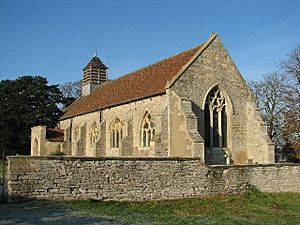St Michael's Church, Cotham facts for kids
Quick facts for kids St Michael's Church, Cotham |
|
|---|---|

St Michael's Church, Cotham, from the south-east
|
|
| Lua error in Module:Location_map at line 420: attempt to index field 'wikibase' (a nil value). | |
| OS grid reference | SK 794 476 |
| Location | Cotham, Nottinghamshire |
| Country | England |
| Denomination | Anglican |
| Website | Churches Conservation Trust |
| History | |
| Dedication | Saint Michael |
| Architecture | |
| Functional status | Redundant |
| Heritage designation | Grade II* |
| Designated | 16 January 1967 |
| Architectural type | Church |
| Style | Gothic |
| Groundbreaking | 12th century |
| Completed | 1890 |
| Specifications | |
| Materials | Stone, tile roofs |
St Michael's Church is an old Anglican church located in the village of Cotham, Nottinghamshire, England. It's called a "redundant" church because it's no longer used regularly for church services. This special building has been around since the 1100s!
Contents
What Makes This Church Special?
St Michael's Church is a very important historical building. It's listed as a Grade II* building on the National Heritage List for England. This means it's a really special place that needs to be protected. The church is now looked after by the Churches Conservation Trust. This group helps to save old churches that are no longer used for regular worship.
The church stands in a quiet field, far away from the main road. It's a peaceful spot that feels a bit hidden.
A Look at the Church's History
St Michael's Church was first built in the 12th century, which means it's over 800 years old! Over the years, parts of it were changed and added in the 14th and 15th centuries.
In the late 1700s, the church's tower and the front part of the nave (the main area where people sit) were taken down. Then, around 1832, some parts of the church were rebuilt. A small bell tower, called a bellcote, was added in 1890.
Even though the church was officially declared "redundant" in 2004, it is still sometimes used for special church services.
How the Church Was Built
Outside the Church
The church is made from rough stone pieces, called rubble, with smoother, cut stones, called ashlar, used for details. It has a roof made of tiles. The church has a simple shape, with the main seating area (nave) and the altar area (chancel) under one roof. There's a porch on the south side and a small bellcote at the east end with a pointy roof.
Along the sides of the church, you can see buttresses. These are stone supports that help hold up the walls. At the west end of the church, there's a window with two sections. The north wall has a door and two windows, each with three sections. The south wall has four windows, also with three sections each. The window at the very east end also has three sections.
Some of the windows have fancy stone patterns called tracery. These patterns are in styles from the Decorated and Perpendicular periods. Above the entrance to the porch, there's a stone cap and a stone that says "1830".
Inside the Church
When you go inside, to the east of the door, you'll find a piscina from the 14th century. A piscina is a stone basin used for washing sacred vessels. On the west wall, there are five stone brackets called corbels. The top two are plain and might show where an old balcony used to be. The bottom three have cool carvings of faces from the medieval times.
The font, where baptisms take place, is shaped like an octagon and also dates back to the 14th century. There are also two old memorials from the 14th century on the south wall. They are partly hidden by the wall and the raised floor.
Outside the Church Grounds
On the east side of the church, there's a stone wall from the 1800s. It has iron gates and some re-used stone carvings called gargoyles from the 14th century. This wall is also a Grade II listed building, meaning it's historically important too.
See Also
- List of churches preserved by the Churches Conservation Trust in the English Midlands
- Grade II* listed buildings in Nottinghamshire
- Listed buildings in Cotham, Nottinghamshire

